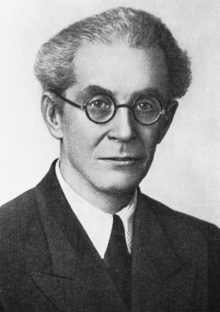Sergei Brukhonenko
Sergei Brukhonenko | |
|---|---|
| Серге́й Брюхоненко | |
 Brukhonenko in 1942 | |
| Born | Sergei Sergeevich Brukhonenko 30 April 1890 |
| Died | 20 April 1960 (aged 69) |
| Nationality | Soviet |
| Awards | Lenin Prize |
Sergei Sergeevich Brukhonenko[a] (Russian: Серге́й Серге́евич Брюхоненко; 30 April 1890 – 20 April 1960) was a Soviet physician, biomedical scientist and technologist during the Stalinist era. Brukhonenko's research was vital to the development of open-heart procedures in Russia. He was one of the leaders of the Research Institute of Experimental Surgery, where Professor Alexander Vishnevsky performed the first Soviet open-heart operation in 1957.
Brukhonenko is primarily remembered for his development of the autojektor, one of the first heart and lung machines. The device was used to mixed results in a series of experiments with canines during the year 1939, which can be seen in the film Experiments in the Revival of Organisms. While there is some speculation today that the film is a re-staging of the procedures, the experiments themselves were well documented, and resulted in Brukhonenko being posthumously awarded the prestigious Lenin Prize.
Career
Brukhonenko received his secondary education in Saratov, later joining the medical faculty of Moscow State University. He was drafted to serve in World War I in 1914,[2] witnessing numerous combat injuries while assigned to the active army as a junior physician. He returned in 1917 to work in Moscow.[3] During 1919 to 1926, Brukhonenko was the assistant professor at the Department of Clinical Pathology and Therapy in Moscow.
Brukhonenko's work in creating the autojektor, an early heart-lung machine, was displayed in a series of experiments with canines in 1939. These experiments are shown in the 1940 documentary film Experiments in the Revival of Organisms, directed by David Yashin.[4][1]
While the film is commonly suspected to be a re-staging of the procedures, as none of the more scientifically questionable experiments are shown in full-frame shots, the experiments in question were documented thoroughly. Additionally, the film's claim that dogs had been drained of blood and revived to live for years after was found to be only partially true, as according to the lab records the dogs survived for only days after the experiment, not years as the film claimed, and suffered serious brain damage.[4][5]
Through 1951 to 1958, Brukhonenko lead the Institute of Experimental Surgical Devices and Instruments.[3][6] Following his experiments with canines, Brukhonenko was granted permission to continue his autojektor experiments with human cadavers. However, these experiments failed to produce encouraging results, resulting in Brukhonenko losing favor with Soviet leadership.[7]
Brukhonenko died 20 April 1960 from rectal cancer.[6][7]
Legacy
in 1965, 5 years after his death, Brukhonenko was posthumously awarded the Lenin Prize for advancing knowledge of artificial blood circulation and laying the ground for future advancements.[7][8]
His experiments laid the groundwork for further advancements in cardiac surgery in the Soviet Union.[3][7][9]
Decorations
 3rd class of the Order of Saint Stanislaus (1914)
3rd class of the Order of Saint Stanislaus (1914) 3rd class of the Order of Saint Anna (1915)
3rd class of the Order of Saint Anna (1915) Lenin Prize (1965, posthumously)
Lenin Prize (1965, posthumously)
Notes
References
- ^ a b Krementsov, Nikolai (June 2009). "Off with your heads: isolated organs in early Soviet science and fiction". Studies in History and Philosophy of Biological and Biomedical Sciences. 40 (2): 87–100. doi:10.1016/j.shpsc.2009.03.001. ISSN 1879-2499. PMC 2743238. PMID 19442924.
- ^ "Брюхоненко Сергей Сергеевич (1890 – 1960)" [Brukhonenko Sergei Sergeevich (1890 - 1960)]. Российский государственный архив в г. Самаре (in Russian). Retrieved 28 May 2023.
- ^ a b c Konstantinov, Igor E; Alexi-Meskishvili, Vladimir V (2000). "Sergei S. Brukhonenko: the development of the first heart-lung machine for total body perfusion". The Annals of Thoracic Surgery. 69 (3): 962–966. doi:10.1016/s0003-4975(00)01091-2. ISSN 0003-4975. PMID 10750806. Retrieved 28 April 2017.
- ^ a b Bellows, Alan (2009). Alien Hand Syndrome: And Other Too-Weird-Not-to-Be-True Stories. Workman Publishing Company. pp. 31–33. ISBN 9780761152255. Retrieved 2 March 2020 – via Internet Archive.
- ^ "Собачье сердце, собачья голова" [A dog's heart, a dog's head]. Naked Science (in Russian). 23 January 2014. Retrieved 10 December 2022.
- ^ a b "Брюхоненко Сергей Сергеевич :: Известные личности :: Первая мировая война" [Sergei Sergeevich Bryukhonenko :: Famous Personalities :: World War I]. Памяти героев Великой войны 1914-1918 (in Russian). Ministry of Defence of the Russian Federation. Retrieved 28 May 2023.
- ^ a b c d Glyantsev, Sergey P.; Bogopolsky, Pavel M.; Tchantchaleishvili, Vakhtang (2018). "Bryukhonenko's Autojector: The First Apparatus for Cardiopulmonary Bypass and Extracorporeal Life Support". ASAIO Journal. 64 (1): 129–133. doi:10.1097/MAT.0000000000000605. ISSN 1538-943X. PMID 28617693. S2CID 24010887. Retrieved 28 April 2017.
- ^ "Портрет: С.С.Брюхоненко | Летопись Московского университета" [Portrait: S.S. Bryukhonenko | Chronicle of Moscow University]. Летопись Московского университета (in Russian). Retrieved 28 May 2023.
- ^ Ivanyushkin, A. Y.; Reznik, O. N.; Popova, O. V. (2 February 2020). "Sergei Brukhonenko – the founder of cardiopulmonary bypass (philosophical, methodological and sociocultural context)". Russian Journal of Transplantology and Artificial Organs. 21 (4): 147–154. doi:10.15825/1995-1191-2019-4-147-154. ISSN 2412-6160.
Further reading
- Adamenko, N. P. (1969). "[Technic of experimental resuscitation of dogs with a variant of the method of extracorporeal circulation using S. S. Briukhonenko's autojector pump and a live parabiotic donor]". Patologicheskaia Fiziologiia I Eksperimental'naia Terapiia (in Russian). 13 (3): 69–71. ISSN 0031-2991. PMID 5264992.
